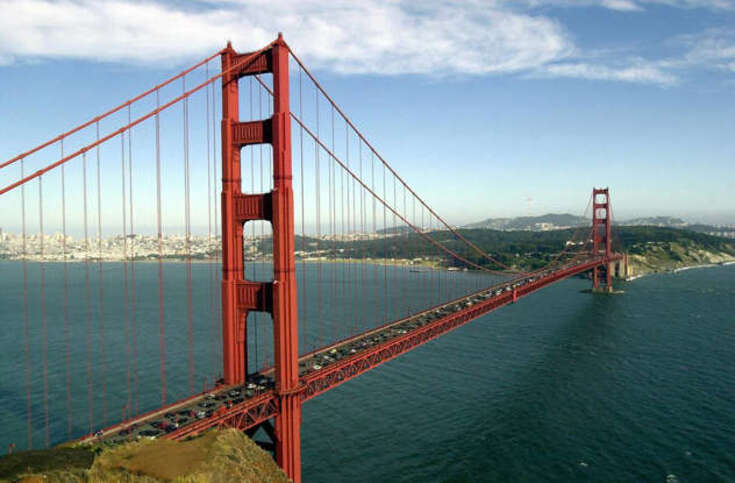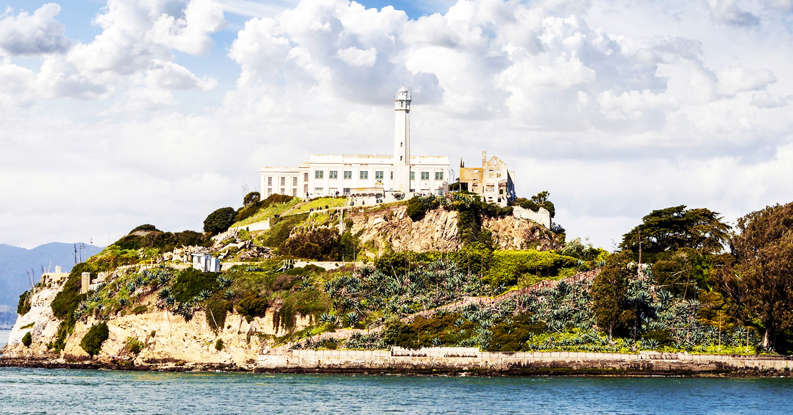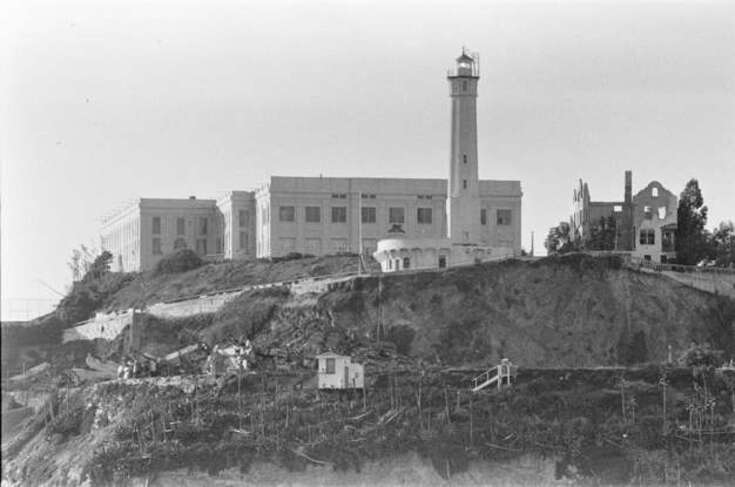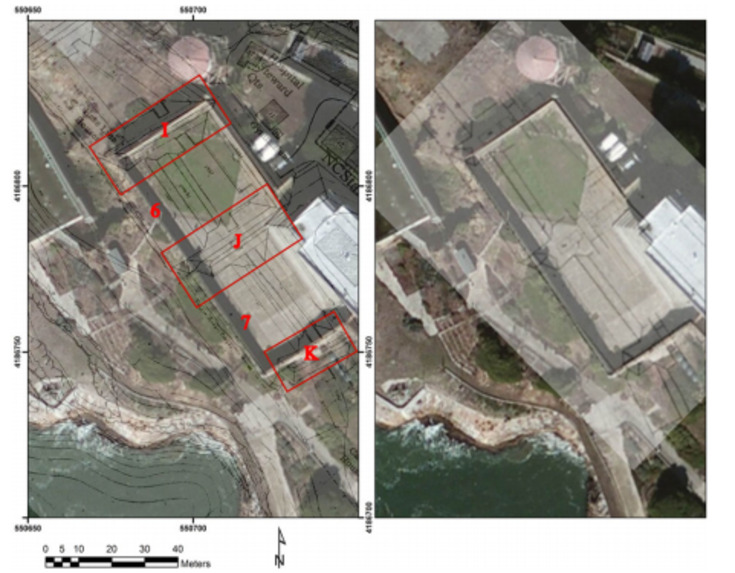Discover the Hidden Story of Alcatraz’s Underground Military Base
For most people, “Alcatraz” might evoke the image of an old, impenetrable prison fortress off the coast of San Francisco. A place of captivity where no one would dare to escape—uninhabitable and solemn. However, besides its history of criminal correction and military utility, researchers recently discovered that Alcatraz also houses an incredible collection of long-buried secrets.
Join us in excavating the exciting mysteries beneath this historic island.
From Guiding Light To Guardpost
The island’s first intended purpose was not as a place to hold convicts—but to keep cattle. Alcatraz was given to a man named Julian Workman by Pio Pico, the Mexican governor of Alta California, on the understanding that he would build a lighthouse there to guide ships as well as his ranch.

Source: Universal History Archive/Universal Images Group via Getty Images
One year later, after a protracted conflict with its neighbor to the north, Mexico found itself in a situation where it had no choice but to cede much of its territory to the United States—including San Francisco.
The Short End Of The Stick
Acting on behalf of the United States government, John Fremont, the newly installed Military Governor of California, bought Alcatraz for $5,000. Fremont expected the government to reward him with a large payout for the purchase of the island. Unfortunately, this would not come to pass.

Source: Universal History Archive/Getty Images
At the behest of President Fillmore, the United States government declared that they would simply acquire the island for military purposes, leaving Fremont without an island or compensation for his efforts. Naturally, Fremont did not take this news very well.
Left High And Dry
Fremont may as well have thrown his $5,000 investment into the sea. The United States government declared that his purchase of the island was invalid since it already belonged to them. Despite his protests, he was left high and dry without so much as a “thank you.”

Source: Heritage Art/Heritage Images via Getty Images
Fremont took the only recourse available to him—legal challenge. Over the next forty or so years, Fremont and his family fought the United States government in court to regain his losses. Unfortunately, his efforts were fruitless.
The Original Spanish Name
The original Spanish name of the island, La Isla de los Alcatraces, roughly “ Island of the Pelicans” in English, was coined by the Spanish explorer Juan Manuel de Ayala in 1775. This lengthier name later became “Alcatraz Island” following the Mexican land cession.

Source: Buyenlarge/Getty Images
The island would have made a good place for cattle as per its original use with its 22 acres of size. The island is 138 ft above sea level at its highest point. From there, you can see the Alcatraz Penitentiary on the shoreline.
Building The Base
By 1853 the United States began construction of a fort on Alcatraz Island. With the Gold Rush in full swing at the time, the authorities felt the need to establish a base to keep the city secure. The promise of fortune saw San Francisco go from a population of 300 people to 30,000.

Source: Tom Szczerbowski/Getty Images
The military commissioned a fort to protect the United State’s interests in the area. Overseeing the project was an engineer by the name of Zealous Tower. Soon the island was humming with construction.
A Rock Solid Base… For Incarceration
Alcatraz Island wasn’t the only base in the area. The military dug in at Fort Point, on a neighboring island. The two locations would help the country safeguard all those new arrivals should there be trouble. The engineers went all in on the job.

Source: Justin Sullivan/Getty Images
The base became one of the most secure structures in the country. They probably imagined that the walls around them would keep anybody out for at least 1,000 years—little did they know it would go on to lock just about anybody inside.
The Perfect Place For Defence
The engineers at the time knew that they were building in an indomitable location. Remarking on their tactical luck, the Pacific Coast Board of Engineers commented, “Nature seems to have provided a redoubt for this purpose in the shape of Alcatraz.”

Source: MBPROJEKT_Maciej_Bledowski, iStock
From the island, the personnel wouldn’t just be able to repel invading forces, but they would easily be able to sink them as well. It covers […] the space lying between Angel Island to the north, San Francisco to the south, and the outer batteries to the west.”
Exploiting Their Natural Advantage
In laying out his plans, Zealous Tower took the naturally solid foundations of the island and built upon them. Rock from the island was used to throw up great walls along the coastline, saving costs and packing the island’s defense all in one stroke.

Source: National Park Service, Golden Gate National Recreation Area/Getty Images
Behind these intimidating walls were gigantic cannons called columbiads pointing out to see in southern, western, and northern directions—11 of these monsters in total—making Alcatraz a formidable force to be reckoned with, should anyone be foolish enough to attempt to test them.
The Fort’s Full Spread
Not only was the fort fully stocked with cannons pointing in just about every direction that mattered, as well as offering a sheer rock face for anyone looking to scale the perimeter, but the fort also boasted caponiers—short towers that jutted out from the shoreline.

Source: Staff/Mirrorpix/Getty Images
This impregnable citadel was finished within twelve months. Pio Pico’s lighthouse would eventually go up by the barracks, but it went up at the behest of the United States military. The lighthouse was the first navigational light constructed in the country.
Keeping The Light Lit
The lighthouse wasn’t just for the safety of the nearby vessels. It was of strategic importance and, being the first of its kind, symbolic. To safeguard it, anywhere between 100 and 200 soldiers could be outfitted and deployed on Alcatraz at any given moment.

Source: Dave Etheridge-Barnes/Getty Images
Since the fort would need to be packed to the brim with soldiers, even the barracks had to have shooting windows to fire through. Additionally, the fort would need to contain enough supplies to keep two legions fed for months at a time.
A Might Untested
It seems the engineers behind Alcatraz did their job a little too well and made the fort too intimidating to take on. With 350 serving men placed at the island fort, it never saw action—not even a minor conflict—all throughout the civil war.

Source: MPI/Hulton Archive/Getty Images
While intelligence officers did uncover a Confederate plot to take the fort on, it never materialized. Three men were arrested and sentenced to ten years imprisonment for plotting to charge Alcatraz, but they were pardoned by President Lincoln when peacetime arrived.
The Finishing Touches
The final touches on Alcatraz Island took longer than planned to complete. They finally finished putting up provisions and decor in 1859. There was a scarcity of skilled laborers in San Francisco at the time.

Source: Camerique/ClassicStock/Getty Images
With the gold rush in full swing, many people were flocking to San Francisco, but not in search of building work—but in search of gold. Finding enough workers to complete the smaller tasks for the island proved to be a challenging task, but it did get done almost a decade later.
Built For A Different Purpose
Today, Alcatraz Island is remembered for its prison construct rather than its military history. Interestingly, these two stories intersect as the first individuals held captive on the island were military soldiers in 1859. During the Civil War, Alcatraz housed captured Confederate soldiers.

Source: Paolo KOCH/Gamma-Rapho via Getty Images
Although the fort was not initially envisaged as a prison, it was clear from the beginning that the island would serve that purpose well. With peace on the horizon, it was only a matter of time before that secondary purpose materialized.
Thick Walls To Keep Them In
The government soon repurposed Alcatraz to hold civilians. The first prisoners began to arrive in 1934. The island was the ideal holding pen for several reasons. First, the obvious—the prison was surrounded by a freezing cold ocean.

Source: US Army Air Corps/PhotoQuest/Getty Images
These waters were not only cold but extremely choppy. The waves were enough to break even the strongest of swimmers. Of the 14 escape attempts, none were successful, although one person managed to make it ashore, but not without paying a high price to his health.
A Thickening Prison Population
Alcatraz transitioned into a prison complex gradually. The fort had its own jailhouse as early as 1867, but it could only handle a few inmates. During the American-Spanish conflict, the jailhouse had expanded. The fort could hold and feed over 450 prisoners.

Source: PhotoQuest/Getty Images
Concrete prison cells were added across the island. By 1933 the military handed over control of the island to the Prisons Bureau, which began turning the site into a full-time penitentiary. Besides a clean-up and minor refurbishment, they would have little to do to prepare.
A Firm Hand To Maintain Order
On August 11, 1934, Alcatraz Penitentiary opened its doors to its inaugural cohort of prisoners, hand-picked due to their disruptive behavior at other facilities. These inmates were in for a change of pace on the remote island prison. Alcatraz’s first warden, James A. Johnston, was responsible for maintaining order among these rowdy convicts.

Source: Bettmann/Getty Images
Known for his strict disciplinary measures, Warden Johnston was the ideal candidate for the job. With a team of 155 guards to assist him, he was tasked with maintaining peace and order on the island prison.
Celebrity Inmates At Alcatraz
With Alcatraz fully operational as a penitentiary, it soon became a hub for housing some of the United State’s most infamous figures. Names like George Kelly and Al Capone likely still ring familiar today. Alcatraz is where they ended up serving their time.

Source: Donaldson Collection/Michael Ochs Archives/Getty Images
Perhaps the most notorious was Alvin “Creepy” Karpis, labeled “Public Enemy Number One” by the FBI. He was one of only four ever to receive this “distinction” and the only one of the lot to be captured alive by authorities.
“Inescapable” Alcatraz—Or Was It?
Throughout Alcatraz’s history, it was the site of 14 escape attempts. None of the prisoners who attempted to flee the island were confirmed to have reached the mainland. Six lost their lives, 23 were recaptured, and two drowned. The remaining five are “missing and presumed drowned.”

Source: Warner Brothers/Getty Images
While impossible to prove that anyone ever successfully escaped Alcatraz, it remains a possibility. Given the island’s challenging conditions, it is considered unlikely that anyone made it to shore. Only one did—but he subsequently fell unconscious in hypothermic shock.
Beating The Odds
The 13th escape attempt from Alcatraz Penitentiary was truly an intriguing episode. Three convicts, John Anglin, Clarence Anglin, and Frank Morris, executed a meticulously planned breakout and braved the icy waters of the San Francisco Bay.

Source: Bettmann/Getty Images
This daring escape was retold on the big screen in the 1979 film Escape from Alcatraz, starring Clint Eastwood. But there’s more. In 2013, a letter purporting to be from John Anglin was delivered to the authorities, leaving many to wonder if these three prisoners somehow survived the treacherous currents.
Closing The Prison Doors
By the 1960s, it had become impossible to keep Alcatraz open as a penitentiary. For one, it was too costly to pay for all the inmates. Each head would cost the prison $10 a day compared to that of other prisons, which cost $3. There were additional maintenance costs, too.

Source: Gili Yaari/NurPhoto via Getty Images
The island’s infrastructure had been eaten away by salt water. It was also rumored that three inmates had escaped in 1962, although this was never officially confirmed. Finally, following the efforts of Native American activists, Alcatraz was closed.
Alcatraz’s Long-Lost History
Although Alcatraz is often described to have a Spanish discoverer, the island was well-known to many Native American tribes long before foreign ships arrived on the shore of the continent, a sentiment expressed by the historian Troy R. Johnson in The Occupation of Alcatraz Island.

Source: Time Life Pictures
In 1969, a group of Native Americans called The United Indian Tribes occupied Alcatraz to speak out against anti-Native American policies. After two years, some of their views were recognized by President Nixon. The island once again became open to the public.
Digging A Little Deeper
When Alcatraz opened its doors to the public, it became a tourist destination. However, long after Alcatraz had become a popular tourist destination, the Binghamton University team, led by Timothy de Smet, had a scientific mission when they visited the island.

Source: Robert Alexander/Getty Images
The team aimed to study what lay beneath the surface and employed laser scanning technology to peak below the ground. This allowed them to survey the subsurface without causing any physical damage to the site, preserving its integrity as a profitable tourist attraction.
Long-Buried Secrets
With their cutting-edge equipment, de Smet and his team of researchers were able to uncover something about Alcatraz without picking up a single stone or drilling through an inch of concrete. It seems the military back in the 19th century was more dug-in than many people realized.

Source: Binghamton University
They discovered secret passageways running under the former prison’s recreation area. Not only that, but these tunnels were bomb-proof—even coming with ventilation ducts—in case their foes came at them with heavy artillery.
The Secret Rooms And Tunnels
Each traverse contained communication tunnels, as shown by the green arrows here. According to the researchers, the features of the constructions were remarkably well preserved. One of the layers sits directly below the Alcatraz Recreation Yard, separated by a thin layer of concrete.

Source: Binghamton University
These “exploded maps” reveal the sprawling size of the 19th-century military operation. What could they have hidden down there? A hidden command center, or safe room, perhaps? Could fleeing convicts have used these tunnels to escape? While it’s unlikely, it’s a compelling thought.
Why The Cover Up?
Part of the reason for their excellent keeping might be that they were covered over in thin layers of concrete. This would likely have been done a little while after the fort’s initial construction. Here’s an image of the outside of the facility when there were still cannons still facing out to sea.

Source: Binghamton University
One reason these historical constructions were concreted over might be that there was only one regulation protecting cultural heritage—the American Antiquities Act of 1906—and it wouldn’t have applied to Alcatraz, being so young at the time.
Making Breakthroughs Without Breaking Ground
Much of the military fort was bulldozed to make way for the prison complex. With that in mind, de Smet and the team asked whether some constructions of historical value might remain underground at Alcatraz. The non-invasive laser technology used to draw a picture of the below levels was created as a result of that question.

Source: Binghamton University
The team didn’t know what to expect underfoot but were amazed at the condition of the below levels. Given the profitability of Alcatraz, exploring the underground without the tech would have been impossible.
Creating The Cutting-Edge Sensor Technology
While the finding of the secret Alcatraz levels is incredible in itself, the real discovery might have been the development of their laser-and-radar-based sensing technology. This innovation helped push the limits on what archaeology is capable of doing in the future.

Source: Binghamton University
Digging through all that bomb-proof material would have been a lot more challenging. By using “3D depth slices” and “depth scans,” researchers can learn more about the past and share it with the public without the risk of breaking anything on the dig, cutting costs as an added bonus.
